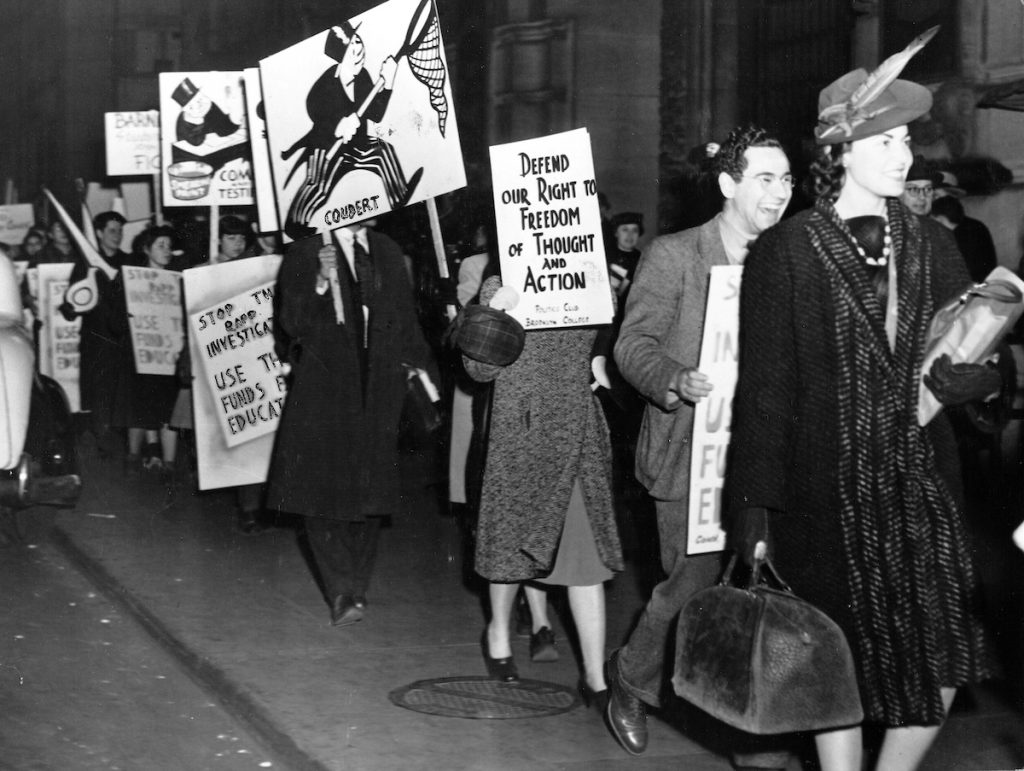Students, faculty, and staff at colleges and universities across the United States and the world are facing an unusually high level of repression for speaking out in support of Palestinians. A city councilwoman brought a gun to a protest outside of Brooklyn College. Billboard trucks displaying the faces and names of pro-Palestine activists are circling the block at Harvard and Columbia. Students are having their job offers revoked. Florida governor Ron DeSantis is trying to ban Students for Justice in Palestine from all Florida schools. Earlier this week, the U.S. Senate unanimously voted a resolution condemning the student protests as “pro-Hamas” and encouraging the U.S. government to “fully and completely support Israel.” On Monday morning, NBC reported that “The departments of Justice and Homeland Security are partnering with campus law enforcement to track hate-related rhetoric online and provide federal resources to schools,” at the direction of the Biden administration. Understandably, students and faculty, especially contingent faculty, are fearful of what might happen to them, even though thousands are speaking out anyway.
But while this level of political repression is a new experience for many of us in U.S. universities, there are many similar examples from history we can turn to for inspiration and guidance. Many people are — correctly — comparing these attacks on campus speech to the McCarthyist purges and climate of fear during the Red Scare. But the example I want to discuss today happened in the 1940s, primarily at the City University of New York (CUNY): the Rapp-Coudert Committee and the student and worker protests against it. As a result of the Committee’s anti-communist investigations, more than fifty faculty members were fired and one was jailed.
Thanks to the hard work of New York City’s librarians, particularly Roxanne Shirazi at the CUNY Digital History Archive, we have access to a lot of archival material documenting not just the hearings themselves, but how students and workers organized to protest the suspensions, firings, and jailings of members of the CUNY community. While the current situation at CUNY around pro-Palestinian speech is not currently as harsh as the era of the Rapp-Coudert committee, our CUNY colleagues from 80-90 years ago can still teach us important lessons on how to fight back against political repression.
The Rapp-Coudert Committee was established by the NY state legislature in 1940 to investigate Communist activities (specifically the Communist Party, CPUSA, rather than anyone with communist politics) within New York public schools. Hearings took place over the course of two years and focused mainly on CUNY, especially City College (CCNY). Teachers fighting back against the Committee argued that it was never actually about “communism” per se, but an attempt to destroy the teachers unions as a first step in dismantling the power of labor across New York State.
Unions Mobilize Against Rapp-Coudert
At this time, CUNY faculty were represented by the NY College Teachers Union (CTU), AFT Local 537, and K-12 public school teachers were represented by the Teachers Union (TU), AFT Local 5. These unions are the predecessors of today’s Professional Staff Congress (PSC-CUNY) and United Federation of Teachers (UFT). Both unions were considered radical, activist unions with a strong Communist presence, although many members were not affiliated with the CPUSA. Members of both unions often collaborated with one another in response to the hearings, including through the formation of a joint committee and newsletter.
Over 500 people were interrogated during the Rapp-Coudert hearings, and more than fifty workers were fired as a result. Some of them were fired because they were outed as communists by colleagues who testified, named names, and sold them out, but some were fired because they refused to testify at all.
This is the first major lesson of the response to Rapp-Coudert: many faculty stood in solidarity with one another and refused to even comply with these red-baiting, anti-worker hearings. If we are called to testify against our colleagues, we must refuse to name names.
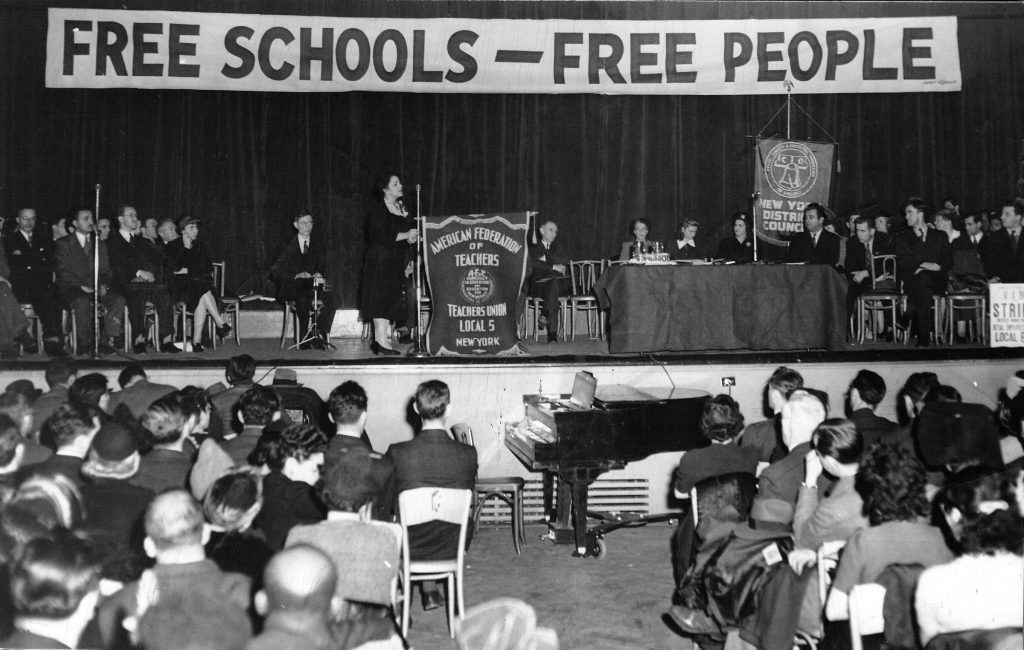
In November of 1940, the Committee requested that the AFT open its books to reveal which teachers were union members. The AFT Executive Committee refused, but nonetheless proclaimed in its statement that it was “unalterably opposed to the penetration into any branch of the American Federation of Teachers of a Communist…or other political faction.” On December 12, 1940, six thousand union members from sixteen different NYC unions gathered to protest the hearings. Two weeks after the December 1940 meeting, the AFT voted to revoke the charters of both the College Teachers Union and the Teachers Union on the grounds of communist activity. Nevertheless, students and workers continued to protest the political repression of professors.
The June 2, 1941 edition of the CTU newsletter shows that the union was now fighting against redbaiting on two fronts: against the Rapp-Coudert Committee, and against the leadership of the AFT. While the AFT voted to revoke its charter, the members of CTU overwhelmingly voted against this move, and the newsletter indicates delegates’ commitment to attend the upcoming AFT National Convention and demand to be seated as union members.
Although they are on a smaller scale than the revocation of a charter, there are also tensions within the Professional Staff Congress right now. The leadership and stewards of the Graduate Center and Professional Schools chapter of the union have nearly unanimously passed a resolution condemning the university’s demonization of pro-Palestinian protests on campus, which was followed by a more moderate statement from the union president, but the union as a whole has been much more reluctant to take a stand on Palestine, after facing significant backlash from a pro-Palestine resolution that narrowly passed the whole-union delegate assembly in 2021. And of course, the AFT as a whole is taking a strongly pro-Israel stance, with AFT President Randi Weingarten explicitly deferring to the Democratic Party’s platform. Many other AFT-affiliates (including the Graduate Employee Organization at the University of Michigan, the Rutgers Adjunct Faculty Union, and the Kansas Graduate Teaching Assistant Coalition) have also released statements in support of Palestine and in opposition to the AFT’s official position.
Students Rally In Support of Teachers And Staff
The 1930s saw an enormous amount of anti-fascist organizing among CUNY students. Once the Rapp-Coudert Committee started targeting workers in the early 40s, the student movement’s demands expanded to protect and support the faculty as well. In 1941, City College’s annual student Peace Assembly was repurposed as a demonstration in support of the suspended faculty and staff and students demonstrated outside the college president’s office.
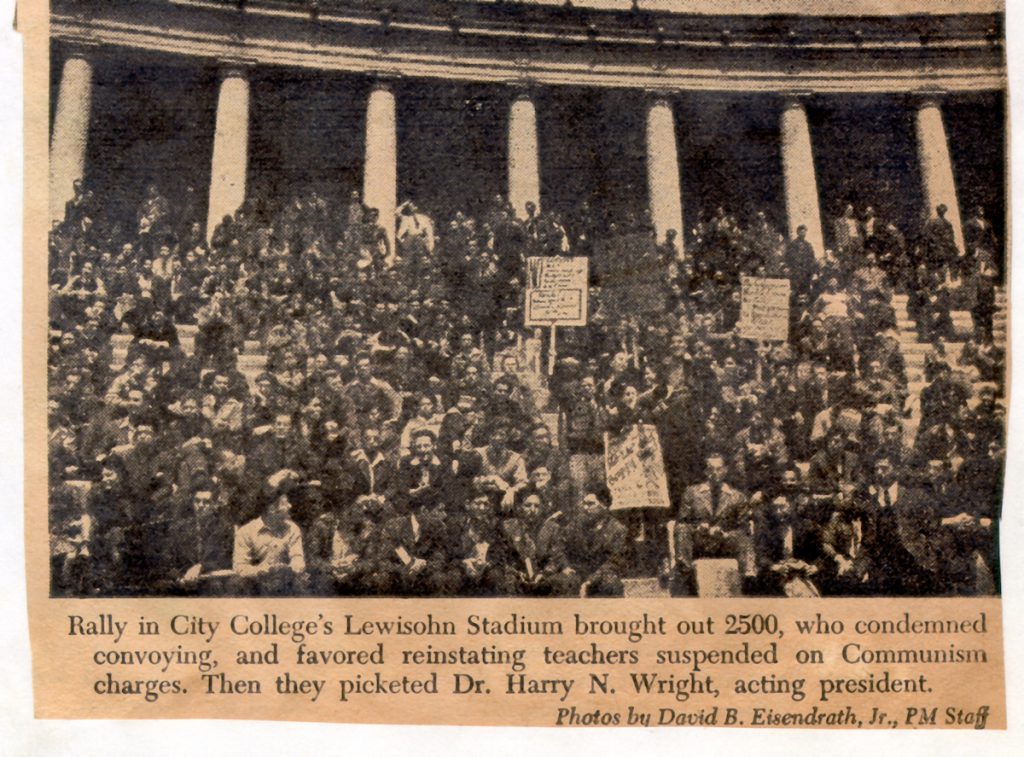
One City College faculty member who was fired was history professor Jack Foner, who was also a CCNY alum himself. When the college hired a substitute teacher after his suspension, his students walked out of class in protest, declared a student strike, and called a meeting for all other students with suspended professors to demand their reinstatement. This call worked: an April, 1941 clipping from The Daily Mirror reports that a class of psychology students also walked out on their substitute teacher. This is another lesson for us to take from that time: students were willing and ready to take militant action in support of their professors facing political repression.
Right now at CUNY, it seems to be students who are facing most of the repression. CUNY faculty and staff must stand up in solidarity with our students and fight for them, just as we hope that they will fight for us if or when we face retaliation. Stories from around the United States suggest that it’s primarily students of color, and Arab and/or Muslim students in particular, who are facing the brunt of the repression. We must defend one another against all forms of oppression and discrimination, including racism, Islamophobia, and antisemitism.
Case Study: The Story of Morris Schappes
As a lecturer in the English department of City College myself, it is Morris Schappes who I think of most often when I reflect on this history. Schappes was a CCNY English lecturer from 1928 through 1941, and though he was beloved by his students, he was fired twice for political activities. (He also co-founded Jewish Currents.)
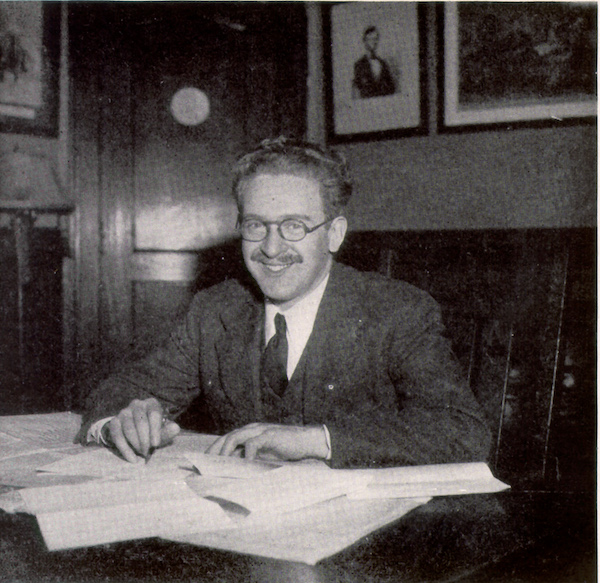
The first time was in 1936. Schappes was a member of the faculty Anti-Fascist Association and organizer for the Instructional Staff Association, a first attempt at creating a faculty union at City College. After a new and highly unqualified department chair took office and accused him of teaching “Karl Marx” (which was actually text from a Percy Shelley essay), he was told that his position was temporary and he would not receive a permanent position — a move widely held to be retaliation for his political activities.
In the nearly a century since Schappes’s first firing, conditions for lecturers at CUNY have improved somewhat. I am still employed on a temporary, year-by-year basis, and I certainly also fear that I will be non-reappointed for political reasons and won’t be able to prove it was retaliation. Right now especially, this is a fear that weighs on my heart, as I am still waiting for the college to determine whether I will be reappointed for next year. But our union — AFT Local 2334, the result of several union splits and/or mergers since the days of Local 537 — has won a “certificate of continuous employment” (CCE) for lecturers, which we are eligible for after five years of work. Schappes was in his eighth year of employment when he was fired, with a seemingly stellar teaching record, based on the archival materials. With a CCE, perhaps he would have been safe.
But he wasn’t. Instead, he was fired during his 9:00 am class, and by the afternoon, hundreds of students were already protesting for the university to reinstate him and twelve other anti-fascist, union organizer faculty. After two months of “widespread pressure,” the City Board of Higher Education voted to reinstate Schappes and the twelve other faculty members, overriding the wishes of CCNY President Robinson. The widespread pressure included a CUNY contingent of hundreds of students marching alongside faculty in their academic regalia in the 1936 NYC May Day rally. Protests work.
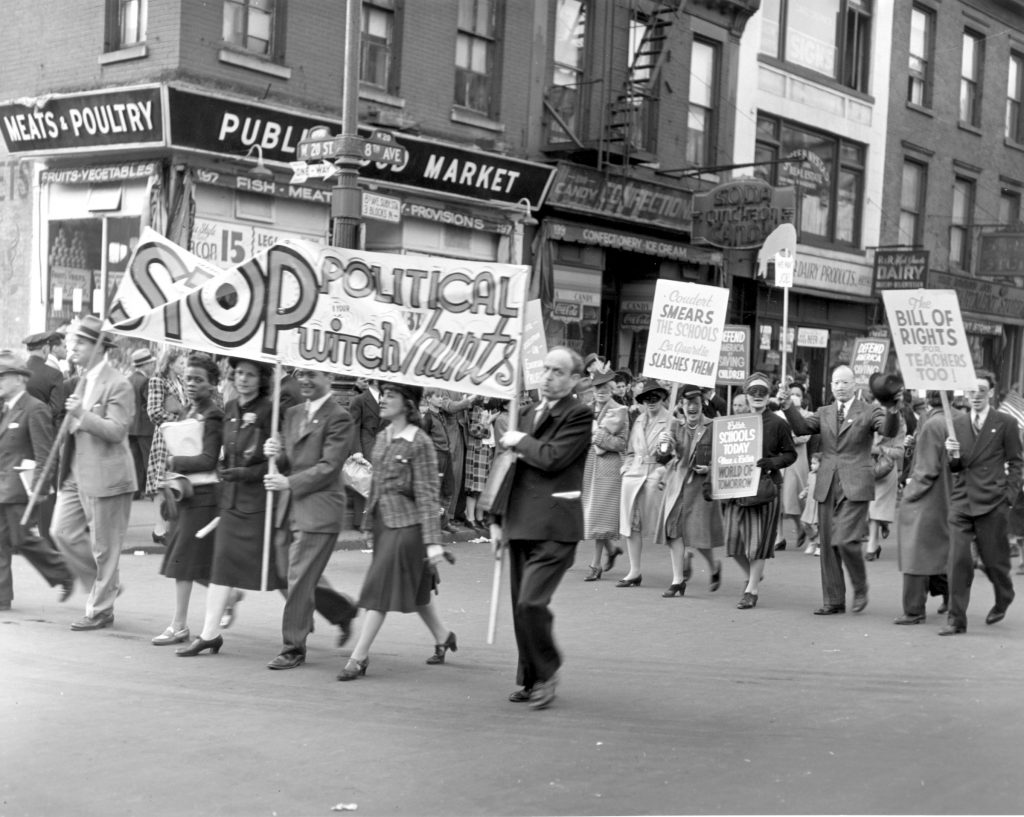
The second time Schappes was fired was in 1941, after being tried by the Rapp-Coudert committee. According to Moe Foner, brother of two CCNY history professors who were also fired for Communist Party ties, it was Schappes himself who decided he would be the “test case” for what would happen if a professor admitted he was a Communist. Schappes (falsely) testified that the only Communists at City College were himself, three who had been killed during the Spanish Civil War, and one other who had already left the school and was already a known Communist. He was found guilty of perjury and jailed for just over 13 months.
Students rallied in his support once again, and a “Free Morris Schappes” committee was formed, with one account estimating that 4,000 City College students walked out of class on April 23, 1941, with thousands more joining them from other schools. A pamphlet issued by “Friends of Morris Schappes” aims to dispel false rumors about the reasons for his firing and includes these quotes from him:
I believe in in political, racial and social equality for Jews, immigrants, Catholics and for that specially oppressed people, the Negro people. I wish to help liberate the cultural energies and productive capacities of the common people from the crippling restrictions placed upon them by big business. I desire to see my students freed from the economic handicaps and the insecurity that is making them aimless in their studies and uncertain of the future that their education cannot help them plan or chart.
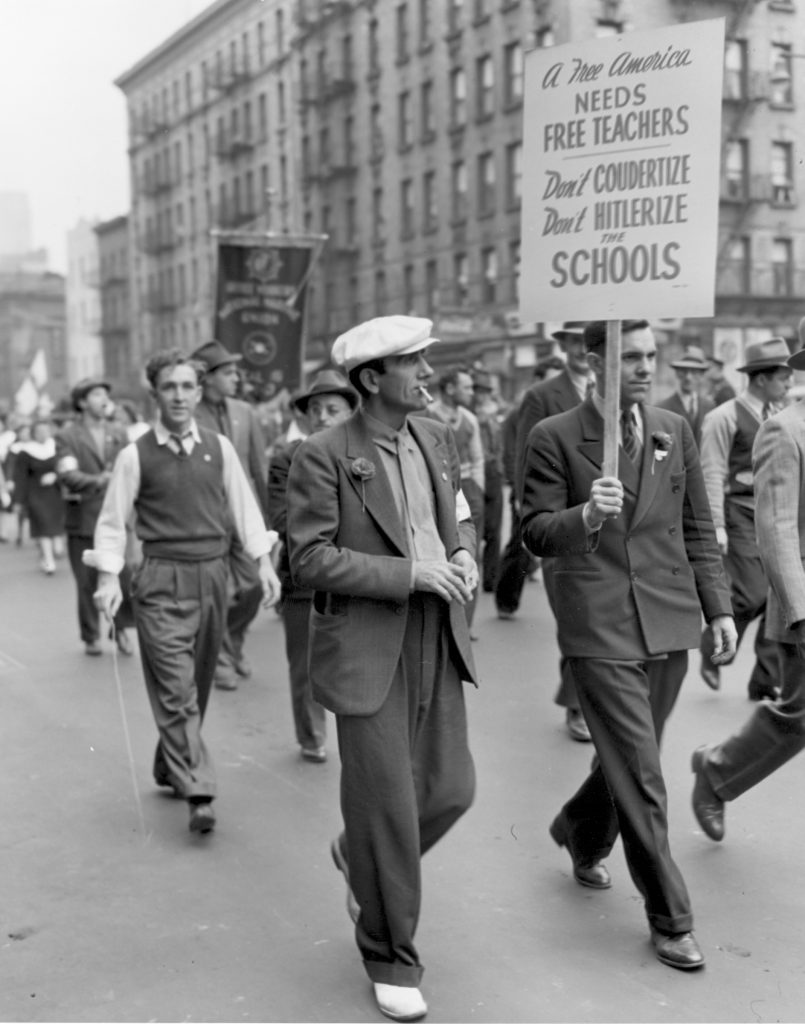
The Committee for Defense of Public Education, consisting of members of both AFT Local 537 and AFT Local 5, issued its own pamphlet calling on their colleagues to fight back against redbaiting in their workplaces and linking the fight against redbaiting to the fight for public education. The pamphlet argues that teachers are being attacked as Communists not because the government is actually concerned about CPUSA members in the schools, but because the teachers’ unions are fighting against budget cuts from the mayor: “As long as the Teachers Union fights against this cut and for better schools, the budget slashers will call the Union red. Do you want the Teachers Union to keep up the fight in behalf of your children? Then help defeat the red-baiters.” The pamphlet called for four action items: writing to the Rapp-Coudert Committee to demand an end to its investigations, writing to the Board of Higher Education to demand the reinstatement of all fired faculty, writing to the District Attorney to demand he drop the charges against Morris Schappes, and writing to the Board of Education to demand it judge teachers solely on their teaching ability and not on the basis of their political leanings.
In its book Winter Soldiers, published in 1941 as a history of the Rapp-Coudert Committee, the unions’ Committee for Defense of Public Education argues that the Committee and the politicians in Albany who sanctioned it — all of the Republicans and all of the Democrats, with only the lone American Labor Party assemblyman voting against it — were taking repressive lessons directly out of Hitler’s playbook to destroy the labor movement and slowly remove all educational content that didn’t serve the interests of the bourgeoisie.
Morris Schappes served 13.5 months in jail. He was never reinstated at City College, and instead made a career as a newspaper writer and as a self-trained historian of American Judaism. The campaign to free and reinstate him did fail. But his political context was very different from the political context we have now.
Lessons From The Past
Red-baiting in 1940 and 1941 was so successful in part because the German-Soviet Non-aggression Pact aligned Stalin — and by extension, the Communist Party — with Hitler. This dealt a major blow to how Communism was perceived by many people, and the U.S. bourgeoisie exploited that propaganda opportunity within the context of the many other ways that World War Two impacted the political situation. In many ways, it worked: the AFT de-chartered three of its most radical unions, which then reformed as more moderate organizations under new charters.
Today, the idea of “socialism” is very popular, especially among young people, and the U.S. labor movement is experiencing a surge of new growth and militancy. The government isn’t sending witch hunt committees after us to weed out the “reds,” and realistically, the administrators at my college do not currently seem very interested in firing people over their statements in support of Palestine.
But the current state of affairs is not guaranteed: the Biden administration’s plan to partner with campus security officers to surveil university activists’ online activity was announced two days after this article was originally drafted, so already, the level of repression is escalating. Because of digital surveillance technology, which didn’t exist in the 1940s, the state has many more tools available with which to repress us. However, through studying this history, we can see what has happened, and imagine what may happen along similar lines. We must be prepared to fight to protect our rights as students, faculty, and staff, our right to speak against injustices — even injustices backed by billions of dollars of U.S. funding.
When I am afraid of getting fired for being political — for leading a union campaign against the administration, for speaking up against genocide — I think of Morris Schappes. He was only 29 the first time he got fired, a year older than I am now. I tell myself that if I get fired, at least I will be in good company.
I also often think of this segment of the poem “Litany for Survival” from Audre Lorde, another former teacher in the City College English department:
“When we speak we are afraid
our words will not be heard
nor welcomed
but when we are silent
we are still afraid
So it is better to speak
remembering
We were never meant to survive.”
Hundreds of students rallying in defense of professors just hours after they’re fired is the kind of campus political climate that all of us at CUNY need to be building, the kind of solidarity that all of us need to be ready to show. None of us are free until all of us are free, and we’re in the very good company of our CUNY activist ancestors.


